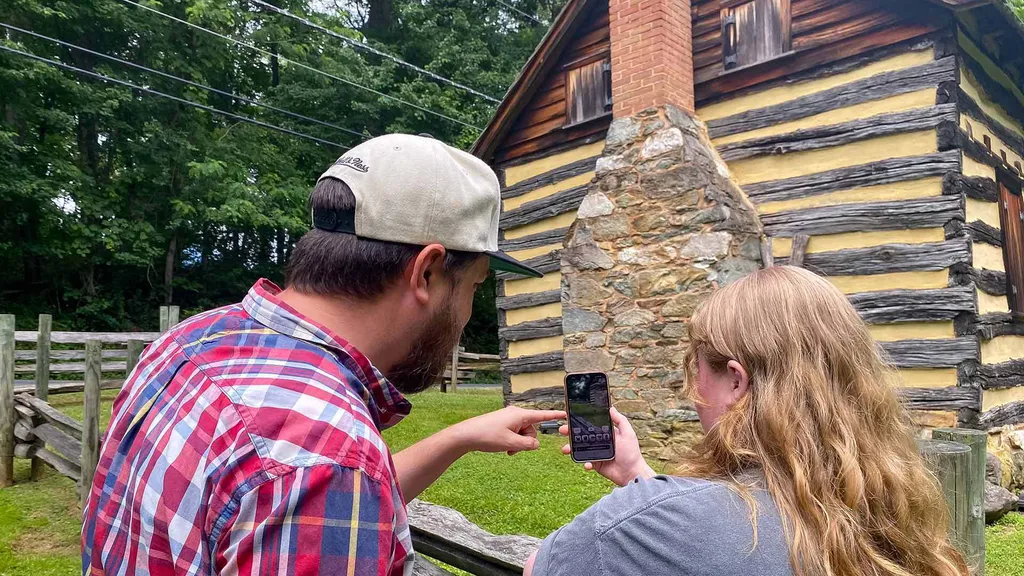- June 18, 2024
- By Brianna Rhodes ’17
Visitors pointing their phones at the unassuming log cabin tucked along a wooded road in Olney, Md., may see a 19th-century wash basin still wet with laundry just outside the back door, chickens roaming around a wooden coop or a neighboring log cabin just yards away.
But when they lower their phones, all that remains is an empty yard and a deeper understanding of this property’s complicated past.
Through augmented reality (AR), a technology that overlays live scenes with computer-generated imagery, visitors to this African American heritage site in Montgomery County can now envision the livelihoods of Black families who lived in Oakley Cabin after the Civil War. Developed by the University of Maryland in collaboration with Montgomery County’s parks and technology departments, the project of digital recreations is believed to be the first AR experience created for an African American historic site in Maryland.
“This really important period of American history and the Black experience is underrepresented in academic research, in public sites and interpretation,” said Stefan Woehlke M.A. ’13, Ph.D. ’21, a postdoctoral associate in UMD’s Historic Preservation Program. “It was really important to me to work on a site where the county government is putting resources into and sharing this period of history through these digital tools.”

Oakley Cabin was one of three cabins originally built in the 1820s as part of the 100-acre Oakley farm. The 1½-story oak and chestnut log cabin housed enslaved laborers until the emancipation of enslaved Marylanders in 1864; it was home to free Black tenant families, up to 10 people at a time, well into the late 20th century. Montgomery Parks took over the property in 1976 to transform it into a museum to highlight Black life post-emancipation.
County officials tapped Woehlke as a project partner last summer. With graduate student Rachel Wilkerson ’23, M.A. ’25, immersive media design student Isabelle Klimanov ’24 and history alum Kyle Houston ’23, Woehlke used digital laser scanning and photogrammetry to turn thousands of images of the site into 3D models and flyovers of the cabin's interior, exterior and landscape. Tech specialists used the imagery to create interior and exterior recreations that include historic artifacts and the two long-demolished cabins. By scanning QR codes, visitors can immerse themselves in eight different AR experiences, including virtual park guides in seven languages, videos that recreate the historical surroundings, 3D models of the cabin’s interior and exterior, and interactive games.
Because Oakley Cabin is one of 17 historic sites across the county and staffing is limited, the interior of the cabin is staffed and accessible to visitors only from April to October on two Saturdays a month. Through AR programs, visitors can learn about the history of a property 365 days a year, especially during observances like Black History Month and Juneteenth.
“There are so many important historical sites across Maryland filled with artifacts and information from the lived experiences of these communities, and programs like this make them so much more accessible,” said Klimanov.
Woehlke has been conducting similar research in Black historic neighborhoods in Maryland for the past 10 years, including the Lakeland community in College Park and North Brentwood, the second town incorporated by a Black community in Maryland and the first in Prince George’s County. He has experimented with integrating imagery and oral histories into video game technology to develop digital tours that highlight significant sites, like Sis’s Tavern in North Brentwood, one of the region’s famed jazz haunts. This past spring, he and students used photogrammetry tools to scan North Brentwood’s AME Zion Church to build a digital interpretation of the site.
Montgomery Parks’ cultural resources stewardship supervisor, Cassandra Michaud, said that with the Olney AR cabin project, the county hopes to help shape a new digital era of historical site discovery and exploration throughout the region. It’s also looking to collaborate with Woehlke in the future at other African American historic sites such as the Josiah Henson Museum and Park in North Bethesda and Johnson Local Park at Emory Grove in Gaithersburg.
“This technology can create a new experience of something that is no longer there,” Michaud said. “We really want people to go to the place, experience it and [develop] their own understanding of it.”
Former Montgomery County Historical Preservation Commissioner Warren Fleming, who helped conduct the first site visit and restoration to the cabin, said the technology can finally help tell Black history the right way.
“In order to get the true meaning of how life was for African Americans during this period, it's important to come out now to this site and get the true education,” he said.
